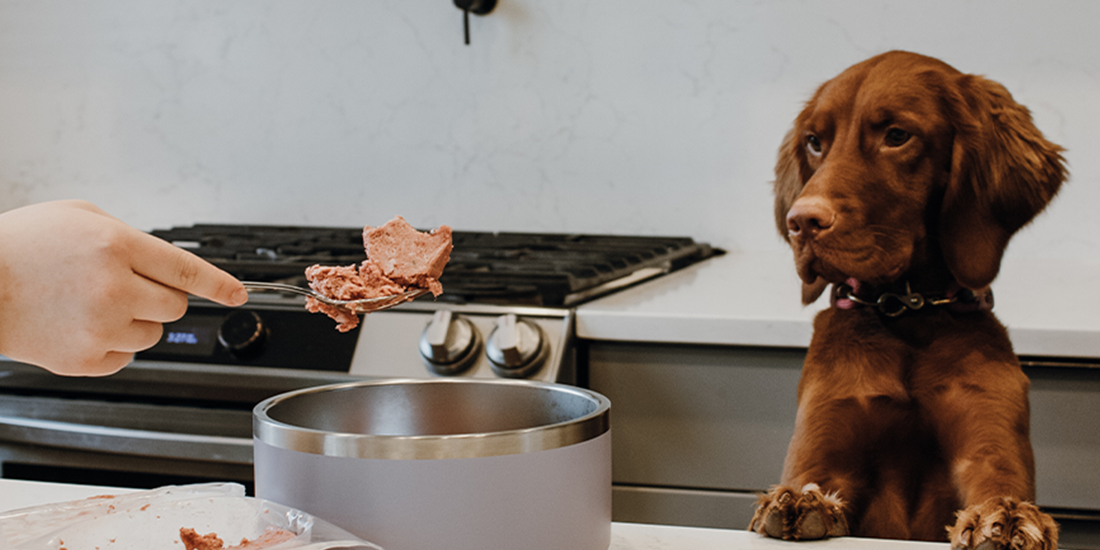[vc_row][vc_column][vc_column_text css=””]
Many dog owners wonder, “Why does my dog eat so fast?” The answer lies in their evolutionary history and instincts. In the wild, dogs had to compete for resources, and eating quickly was a survival tactic. However, in a domestic setting, eating too fast can lead to various health issues.
Let’s explore the reasons behind rapid dog eating, what happens if a dog eats too fast, and offer suggestions on how to slow down dogs eating.
[/vc_column_text][/vc_column][/vc_row][vc_row][vc_column][vc_row_inner content_placement=”middle”][vc_column_inner width=”1/2″][vc_column_text css=””]
My dog eats too fast: Understanding the need for speed
Instincts from the wild
The answer to why do dogs eat so fast all stems from their instinctual history. In the wild, dogs had to fend for themselves, and competition for food was fierce. Those who ate quickly were more likely to consume their share before it was taken by a competitor. While domesticated dogs no longer face such challenges, the instinct to eat rapidly remains ingrained in their behaviour.
Competition in multi-pet homes
If you have multiple pets and ever thought “wow, my dog eats too fast”, there could be a simple explanation for that. Even in a domestic setting if you have multiple pets, there may be an unconscious competition for food. Dogs may feel the need to eat quickly to ensure they get their fair share before another pet can swoop in. This may not be true for all situations, but it is certainly something to consider.
A love for food.
The truth is, some dogs are more food motivated than others. Certain breeds can be more prone to rapid eating due to their genetic predispositions.
[/vc_column_text][/vc_column_inner][/vc_row_inner][vc_row_inner content_placement=”middle”][vc_column_inner width=”1/2″][vc_column_text css=””]
What are some dog eating too fast symptoms?
Identifying whether your dog is eating too fast involves observing their behaviour during mealtime and monitoring for potential symptoms. Some common signs include excessive swallowing, minimal chewing, and a sense of urgency while eating.
If you catch yourself saying “why does my dog eat so fast”, some digestive issues for your dog such as vomiting or regurgitation might not be far behind. A dog’s digestive system is sensitive, so in severe cases, rapid eating can lead to more serious conditions like bloating or gastric torsion, characterized by a distended abdomen, restlessness, and signs of discomfort.
[/vc_column_text][/vc_column_inner][vc_column_inner width=”1/2″][vc_column_text css=””]

The dangers of speedy eating & what happens if a dog eats too fast
Is it bad for dogs to eat fast? While fast eating might have helped dogs survive in the wild, it can lead to several health issues in a domestic setting. These include:
Choking and gagging
If a dog eats too fast, it may be more prone to choking or gagging on their food. Large chunks may get lodged in their throats, posing a serious risk.
Bloat
Dogs eating too fast can contribute to gastric dilatation-volvulus (GDV), commonly known as bloat. This life-threatening condition occurs when a dog’s stomach fills with gas and twists on itself. When a dog eats too fast, it’s more likely to swallow air, increasing the risk of bloat.
Obesity
Eating quickly can lead to overeating as the body doesn’t have enough time to register fullness. Obesity and other related health issues can arise from dogs eating too fast.
[/vc_column_text][/vc_column_inner][/vc_row_inner][vc_row_inner content_placement=”middle”][vc_column_inner width=”1/2″][vc_column_text css=””]
Tips on how to get dog to eat slower
If you want to figure out how to slow down dogs eating, there are a few things you can try!
Use slow-feeder bowls
Slow-feeder bowls are designed with obstacles or patterns that force dogs to work around them to access their food. This not only gives you an answer to how to slow down dog eating, but it also provides mental stimulation.
Scatter-feeding
Trying to figure out how to get your dog to eat slower? Instead of using a traditional bowl, scatter your dog’s food on a large surface. This encourages them to search for and eat individual pieces, slowing down the overall eating process.
Muffin or cookie sheet
The American Kennel Club says that spreading your dog’s food across a cookie sheet makes it very difficult for your dog to gulp down large amounts, especially if you feed kibble. Your dog will be forced to take tiny bites and pick up a lot of pieces with his tongue (which takes quite a bit of time) and therefore will eat much more slowly.
[/vc_column_text][/vc_column_inner][vc_column_inner width=”1/2″][vc_column_text css=””]

Puzzle toys
Sometimes the answer to “why do dogs eat so fast” can be found in some mental stimulation. Engage your dog’s brain by using puzzle toys that dispense food gradually. This not only extends mealtime but also provides mental stimulation, reducing the likelihood of boredom-related behaviours.
Hand-Feeding
If you’re trying to figure out how to get a dog to eat slower, consider hand-feeding them. This allows you to control the pace at which they consume their food.
Portion-control
Divide your dog’s daily food portion into smaller, more frequent meals. This not only prevents overeating but also helps regulate their digestion.
[/vc_column_text][/vc_column_inner][/vc_row_inner][vc_row_inner content_placement=”middle”][vc_column_inner width=”1/2″][vc_column_text css=””]
So, how fast is too fast for a dog to eat?
While individual dogs may vary, there are general guidelines to help determine if your furry friend is eating too fast. A healthy eating pace for a dog involves a reasonable amount of time spent chewing and savouring each bite. Ideally, a dog should take around 10 to 20 minutes to finish a meal. If your dog consistently devours their food in a matter of seconds, it’s a clear indication of eating too fast.
Consider monitoring mealtime and, if necessary, implementing the aforementioned strategies to slow down their pace. Finding the right balance ensures your dog not only enjoys their meals but also reduces the risk of potential digestive issues associated with rapid eating. If you’re unsure about what constitutes a healthy eating pace for your specific dog breed or size, consult with your veterinarian for personalized advice and guidance.
[/vc_column_text][/vc_column_inner][vc_column_inner width=”1/2″][vc_column_text css=””]
Where can Bold by Nature products be purchased?
Ready to get your pet started on its raw journey and help it slow down its meals? Bold by Nature offers raw dog food in Canada and the US and can be purchased either online or at a local retailer that carries our products!
[/vc_column_text][/vc_column][/vc_row]












